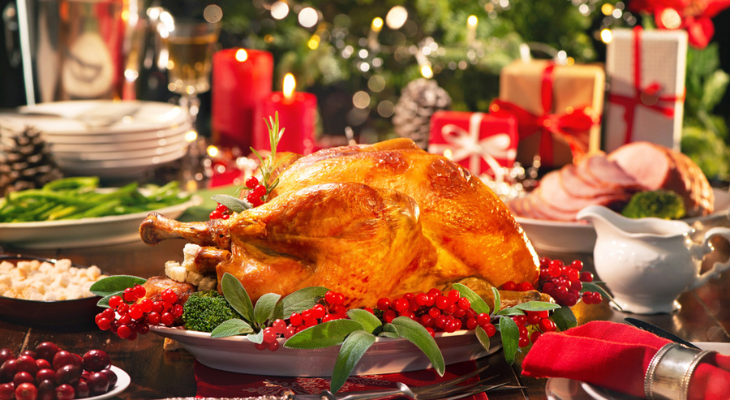
Healthy Eating for the Holiday Season
It's never easy to turn down a holiday treat. After all, special foods are the highlight of the holiday season for many of us. Fortunately, it's possible to follow your healthy eating plan and even enjoy a few favorite snacks by making a few changes to your eating habits.
Why a Healthy Diet Is So Important
A healthy diet includes a mix of fruits, vegetables, low-fat dairy products, whole grains, lean meats (or other sources of protein), and healthy carbohydrates and fats. Unfortunately, the fats and carbohydrates that make holiday foods taste so good are often the unhealthy kind.
White flour and sugar, two unhealthy carbohydrates, are often found in holiday treats. The same foods may also contain undesirable saturated and trans fats, including shortening, margarine, fatty meats, butter, coconut oil, and whole-fat dairy products. Fried and processed foods, in particular, may contain too many carbohydrates and saturated and trans fats.
Although an occasional treat is unlikely to cause health problems, eating a diet high in carbohydrates and unhealthy fats on a regular basis may raise your blood sugar and increase your "bad" cholesterol level. Eventually, you may gain weight or be at risk of developing high blood pressure, heart disease, diabetes, or having a stroke.
How to Eat Healthy During the Holidays
Keeping these guidelines in mind will help you avoid holiday eating pitfalls.
- Keep Hunger in Check. Eat a healthy snack, like low-fat string cheese or peanut butter on celery or apple slices, before you leave for a holiday gathering. When you're hungry, it's much harder to resist sugary, fatty, or fried foods.
- Scope Out the Food Table. Don't fill up on the first foods you see when you arrive at the party. Instead, take a careful look at the selection and load most of your plate with fruits and vegetables. Leave room for a small taste of fatty or high-carb foods like white bread, cake, cookies, or fried foods.
- Rework Favorite Recipes. Many holiday recipes can be modified to reduce sugar or include healthier carbohydrates and lower-fat products without affecting taste. The North Dakota State University Extension suggests lowering sugar and fat in baked goods by 1/4 to 1/3. It notes that fruit purees can make up for lost fat, while cinnamon or vanilla will compensate for reduced sugar.
- Try Sugar Substitutes. Adding sugar substitutes makes holiday treats tasty without substantially increasing carbohydrates. Since stevia, monk fruit, and other artificial sweeteners are often much sweeter than sugar, you'll only need to add a small amount to holiday foods. Experiment with the various kinds of artificial sweeteners to find the one you like best.
- Use the Healthiest Cooking Methods. Baking and roasting are better options than frying. If you do decide to fry, use healthy oils, like canola and olive, sparingly. You'll use less oil if you try oil sprays rather than applying oil with a basting brush, according to a Washington Post article.
- Decrease Portion Size. Occasional treats are perfectly fine, even if you're committed to healthy eating. There's no reason you can't have a piece of cake on your birthday or enjoy your family's favorite holiday cookies. Decrease your usual portion size of cake or pie by 2/3, or buy smaller cookie cutters and bake a selection of large and small cookies to accommodate guests who are counting calories.
- Make Water Your Preferred Drink. Soft drinks, juice, and alcohol are full of calories too. Soft drinks, in particular, contain high amounts of sugar. Stick to water during the gathering, or look for diet or zero-sugar soft drinks and juices.
- Choose Treats Wisely. Do a little research before you attend your company's holiday party or a family get-together. If you know the average calorie, carbohydrate, and fat content in common holiday foods, it's much easier to make healthy choices. For example, Nutrionix reports that a 3" sugar cookie is 147 calories and contains 6.9 grams of fat, 20 grams of carbohydrates, 9.6 milligrams of cholesterol. In contrast, a slice of Oreo cheesecake is 466 calories and includes 33 grams of fat, 37 grams of fat and 135 milligrams of cholesterol.
Need a little help with healthy eating? In addition to easing your aches and pains, your chiropractor offers nutrition advice that will help you improve your health. Give us a call to schedule an appointment.
Sources:
North Dakota State University Extension: Now You’re Cookin’: Recipe Makeovers!, 8/2021
https://www.ndsu.edu/agriculture/extension/publications/now-youre-cookin-recipe-makeovers
Washington Post: Cooking Oil Spray Can Do More Than You Think. Here's How to Get the Most Out of It, 1/18/2019
Harvard Health Publishing: 12 Tips for Holiday Eating, 8/28/2019
https://www.health.harvard.edu/blog/12-tips-for-holiday-eating-201212242506
Nutritionix: Sugar Cookie, Baked - 1 Medium (3" Diameter)
https://www.nutritionix.com/i/usda/sugar-cookie-baked-1-medium-3-diameter/5a3a7d1b1a7a99546acdfdae
Nutrionix: Cheesecake Oreo
